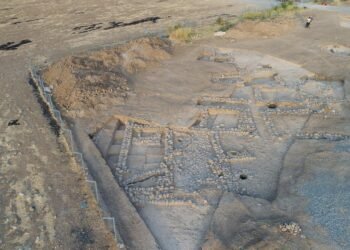Archaeologists have found an early Byzantine business and gastronomy district at Ephesos, an ancient Greek city in modern-day Turkey’s Izmir province that was destroyed suddenly in 614-15 CE.

These shops and workshops were built over a vast Roman square complex, with all of the premises encompassed within. All of the household items in the rooms were sealed by a thick burnt layer and thus preserved for posterity. This makes the discovery comparable to the Pompeii archaeological site, however, it will be dated differently.
Archaeologists believe the rooms served as a cookshop, a storeroom, a workshop, a taberna, and a lamp and pilgrim souvenir shop (as evidenced by the discovery of around 600 small pilgrim bottles sold to Christian pilgrims.)
It is the most significant find in the city since the now-famous Terrace houses were discovered 50 years ago.

An incredibly well-preserved Byzantine business and dining space has been discovered, perhaps the most significant find to date from this site since finding the renowned terrace houses, according to Sabine Ladstätter, the head of the excavation, and the director of the Austrian Archaeological Institute of the Academy.
“That the originally large Roman square complex was built over by shops and workshops in Late Antiquity was to be expected. What was completely unexpected, however, was the state of preservation as well as the exact time of destruction and the implications for urban history that can be derived from it”, said Sabine Ladstätter.
Attic and Ionian Greek colonists built the city on the site of the former Arzawan capital in the 10th century BCE. Ephesos was one of twelve cities that were members of the Ionian League during the Classical Greek era, emerging as a major urban center with great buildings such as the Library of Celsus and a theatre capable of holding 24,000 spectators.
The latest discoveries at Domitian’s Square may now help to answer a mystery in Ephesos’ urban history.

“Although it has so far been possible to observe from the archaeological evidence that the city became smaller by leaps and bounds in the 7th century and the standard of living dropped significantly, the reasons for this were not clear. Coin circulation also plummeted, falling to a much lower level than in the centuries before,” said Ladstätter.
“We will now probably have to link this caesura in the urban history of Ephesos with the Sasanian Wars”






















